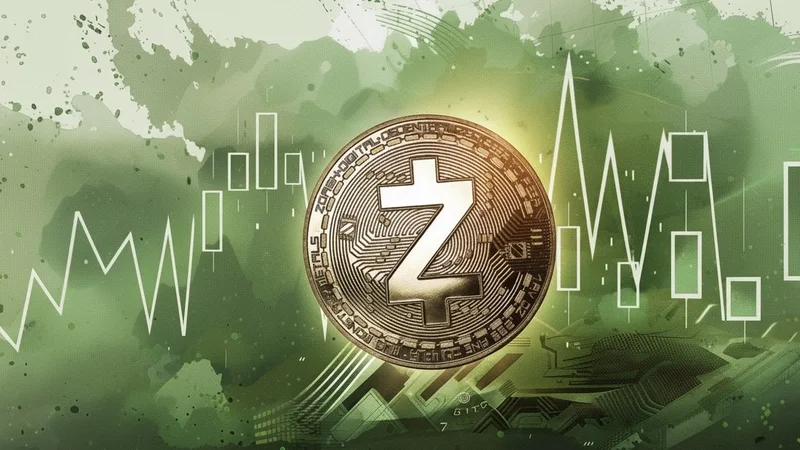Something unusual is happening in the quiet corners of the crypto market. While Bitcoin cools its jets just under $122,000, a forgotten sector is showing signs of life not seen since 2018. Zcash (ZEC), a privacy-focused cryptocurrency that has spent years in a state of quiet irrelevance, has suddenly ignited.
The numbers are, frankly, startling. The `zcash price` is up over 40% in a single 24-hour period, bringing its seven-day gains to more than 85%. In the process, it has become the market's best-performing large-cap token. This isn't an isolated event. The entire privacy cohort—tokens like Dash, Verge, and Railgun—is being pulled up in its wake, with the sector averaging a 15% gain. To be more exact, Railgun’s RAIL token has posted an astonishing 300% gain in one week.
Spot volumes for ZEC alone have cleared $1.1 billion in the past day. This isn't retail curiosity; this is a significant, coordinated flow of capital. The question isn't if something is happening, but why it's happening now, and whether this explosive rally is a genuine signal of a revival or merely a high-beta echo of a bull market running out of fresh ideas.
When a dormant asset moves with this kind of velocity, a stack of narratives is quickly assembled to justify the price action. In the case of `ZEC Zcash`, the primary catalyst appears to be institutional. Grayscale, a major digital asset manager, announced a new ZEC trust fund (a vehicle that provides investors exposure without direct ownership), immediately stoking speculation about a potential Zcash ETF filing.
This is a clean, simple trigger. It provides a veneer of institutional legitimacy that allows larger pools of capital to take notice. Almost immediately, this signal was amplified by high-profile endorsements on social media. Venture capitalist Naval Ravikant labeled Zcash "insurance against Bitcoin," a pithy, marketable phrase that spreads like wildfire. This is the classic one-two punch: an institutional-grade catalyst followed by a retail-friendly narrative.

And this is the part of the cycle that I find genuinely predictable. As broader market liquidity searches for its next target, capital behaves like water seeking the lowest point of elevation. It flows into forgotten assets where valuations are depressed and the potential for parabolic gains is highest. The "privacy" narrative—concerns over financial surveillance, censorship, and government overreach—is a hardy perennial. It never truly dies; it just lies dormant, waiting for the right market conditions to be reactivated. Is it a coincidence that this narrative is re-emerging just as majors like `Bitcoin` and Ethereum take a breather? Or is it simply the most convenient story to attach to a technically favorable trade?
The story becomes clearer when you move past the narratives and look at the flow. The sheer volume on display suggests this is more than just a renewed belief in privacy tech. A $1.1 billion turnover in a single day for a coin like Zcash points to a massive capital rotation. Traders are taking profits from high-flying majors and redeploying them into assets with higher volatility and a compelling short-term story.
This behavior has historical precedent. There’s a long-running heuristic among seasoned traders that outsized ZEC spikes have, at times, served as a canary in the coal mine for a local top in the `Bitcoin price`. It's not a perfect correlation, but it suggests that when speculative fervor reaches the "ghosts" of cycles past—assets like Zcash or Dash—it can signal that the easiest gains have already been made in the blue-chip names.
The rally in Dash, a project long dismissed as a relic, is particularly telling. Its revival isn't based on any groundbreaking technical update but on a renewed conversation around stablecoin regulation, making its legacy "payments" branding suddenly relevant again. This isn't a fundamental re-evaluation; it's a pattern-matching exercise by a market flush with cash. We're witnessing a hunt for beta, where any plausible narrative is enough to justify a trade. But what happens when the narrative hunters move on to the next story? How much of this new capital will remain to form a stable price floor?
Let's be clear: the `Zcash crypto` rally is a masterclass in market dynamics, but it's not a resurrection. This isn't about the sudden, widespread adoption of shielded transactions. It's about liquidity seeking the path of least resistance. The Grayscale news provided the spark, influencers fanned the flames, and a dormant narrative provided the fuel. The result is a spectacular, liquidity-driven bonfire.
But these fires burn out. While the rally means Zcash reclaims $200 level after three years amid renewed interest in privacy coins, the token remains more than 90% below its 2016 all-time high. This context is critical. The current price action is a violent reversion to the mean, amplified by speculative leverage. The real test for Zcash won't be whether it can hit $250 or $300 in this frenzy. The real test is where the `zcash price prediction` settles when the market's attention inevitably shifts elsewhere. Right now, Zcash isn't a signal of a new paradigm for privacy; it's an echo of a market saturated with capital and hungry for volatility.